The demand for ever-more agricultural land to feed the world’s increasing population is perhaps the greatest driver of forest destruction. Researchers have been examining the best methods to re-establish ecological health while at the same time providing multiple socio-economic benefits.
In the Philippines, a team of researchers with the Center for International Forestry Research and World Agroforestry (CIFOR-ICRAF) have been working to protect the environment and, at the same time, improve the livelihoods of smallholders who live and work in it. Their study links to several of the two centers’ global research interests of seeking solutions for environmental degradation and biodiversity loss, unsustainable commodity supply chains, accelerating climate change and increasing inequalities and inequities.
“The major question facing us was how to move from a well-established institutional culture of planting trees,” said Andrew Wardell, principal scientist with CIFOR, “to one of planting, growing and managing trees to make trees the backbone of the rural economy, making money and employment for upland communities while providing goods and services to a broad array of groups. That is, how to create an institutional culture that facilitates the emergence and subsequent strengthening of community-based forestry enterprises that will, in turn, also foster greater domestic and foreign investment in the forestry sector.”
For INREMP, Wardell prepared a policy review and institutional analysis for commercial forestry investment sub-projects, a report on incentive structures for policy and institutional mainstreaming of commercial forestry investment sub-projects and authored one of three policy briefs, Facilitating the shift from tree planting to promoting community-based forest enterprises in the Philippines.
The research was part of technical support to the Integrated Natural Resources and Environmental Management Project or INREMP, which is implemented by the Department of Environment and Natural Resources with funding from the Asian Development Bank. INREMP is one of the world’s most ambitious restoration projects, working in 23 watersheds extending over 11,385 sq km and a human population of around 1.8 million.
We want you to share Forests News content, which is licensed under Creative Commons Attribution-NonCommercial-ShareAlike 4.0 International (CC BY-NC-SA 4.0). This means you are free to redistribute our material for non-commercial purposes. All we ask is that you give Forests News appropriate credit and link to the original Forests News content, indicate if changes were made, and distribute your contributions under the same Creative Commons license. You must notify Forests News if you repost, reprint or reuse our materials by contacting forestsnews@cifor-icraf.org.













